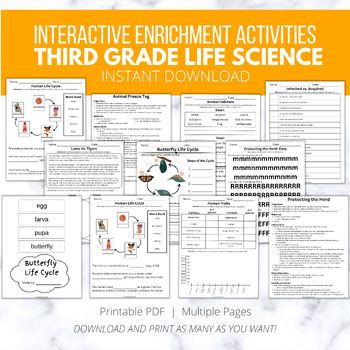Third Grade Life Science Mega Bundle: NGSS Interactive Activities
- Zip
Products in this Bundle (4)
Bonus
Description
Title: Third Grade Life Science Mega Bundle: NGSS Interactive Activities
Key Features:
- Comprehensive life science resource bundle for third grade educators
- Aligned with NGSS standards, ensuring curriculum relevance
- Activities include detailed information pages for easy lesson planning
- Range of teaching modalities cater to various learning styles
- Suitable for independent or teacher-led use, accommodating diverse group sizes
Main Topics:
- Exploration of animal life cycles, traits, habitats, and behaviors
- Engaging activities including games, worksheets, and projects
- Inclusion of a lab following the scientific method for hands-on learning
- Emphasis on interactive and enriching experiences to make learning fun
Unleash the wonders of life science in your classroom with our comprehensive resource bundle designed specifically for third grade educators! Aligned with NGSS standards, this bundle covers a diverse range of topics including animal life cycles, traits, habitats, and behaviors. Each activity comes complete with detailed information pages, step-by-step instructions, objectives, and activity questions, making lesson planning and prep a breeze for busy teachers. With a variety of teaching modalities such as games, worksheets, and projects, students will be fully engaged in exploring the mysteries of the natural world. Whether used independently or in teacher-led settings, our resource bundle caters to diverse group sizes and learning styles, ensuring inclusivity and accessibility for all students. Ignite curiosity and inspire discovery with our dynamic life science bundle - the ultimate go-to for third grade teachers seeking to make learning fun, interactive, and enriching for their students!





